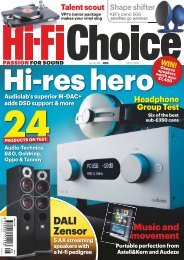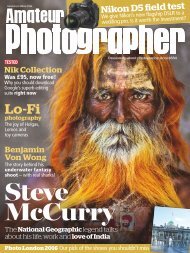You also want an ePaper? Increase the reach of your titles
YUMPU automatically turns print PDFs into web optimized ePapers that Google loves.
space rock killed off much of<br />
the life on Earth, including<br />
the dinosaurs.<br />
Humans now know of a<br />
range of such impacts on our<br />
planet, large and small. But<br />
simply knowing about these<br />
events will not make them<br />
stop. So, to raise awareness<br />
about Near-Earth Objects<br />
(NEOs), Asteroid Day will<br />
take place again in 2016. This<br />
movement — whose founders<br />
include German filmmaker<br />
Grigorij Richters, astrophysicist<br />
and Queen guitarist Brian<br />
May, and Apollo astronaut<br />
Rusty Schweickart — seeks to promote<br />
asteroid discovery and tracking.<br />
With this in mind, members of<br />
Asteroid Day held a news conference in<br />
February at the European Space Agency’s<br />
ESTEC facility near Leiden, Netherlands,<br />
to announce this year’s activities.<br />
Richters led the conference, which<br />
included live guest talks or recorded messages<br />
from May; England’s Astronomer<br />
Royal, Lord Martin Rees; astronautexplorers<br />
Ed Lu, Tom Jones, and Chris<br />
Hadfield; Bill Nye the Science Guy; and<br />
asteroid experts Mark Boslough and<br />
Patrick Michel.<br />
This year, Asteroid Day will take place<br />
June 30, the anniversary of Tunguska,<br />
and celebrations will occur in a variety<br />
of places. Central to the festivities will<br />
be the Starmus Festival, occurring June<br />
27–July 2 in Tenerife, Canary Islands. (For<br />
more on Starmus see “Celebrating Stephen<br />
Hawking’s legacy” in the April issue.)<br />
Events also will take place in Barcelona,<br />
Spain, at the Spanish National Research<br />
Council; in San Francisco,<br />
at the California Academy<br />
of Sciences; in Vienna, at the<br />
Natural History Museum;<br />
in Seoul, South Korea, at the<br />
Gwacheon National Science<br />
Museum; and at many other<br />
facilities throughout the world.<br />
Asteroid Day wants to<br />
include and help coordinate<br />
as many groups and events<br />
as possible. For information<br />
on how to host your own<br />
Asteroid Day event, visit http://<br />
resources.asteroidday.org/<br />
resources/getting-started-withyour-event.<br />
For everything else about Asteroid Day,<br />
see asteroidday.org.<br />
Asteroid Day co-founder and Queen<br />
guitarist Brian May speaks at the Asteroid<br />
Day news conference about the importance<br />
of discovering more Near-Earth Objects.<br />
Asteroid Day co-founder Grigorij Richters<br />
welcomes members of the media to the<br />
announcement of Asteroid Day 2016.<br />
Lord Martin Rees, England’s Astronomer<br />
Royal, describes his keen interest in<br />
tracking asteroids in the inner solar system.<br />
Organizers stress that<br />
Asteroid Day is not about fear.<br />
Planetary scientists know of no<br />
asteroid in near-Earth space as<br />
large as the one that killed the<br />
dinosaurs — and they have been<br />
looking carefully. But even a<br />
relatively small space rock, like<br />
the one that shattered in the sky<br />
above Chelyabinsk, would cause<br />
a huge catastrophe if it struck<br />
a major metropolitan area.<br />
Planetary scientists believe we<br />
have found 90 percent of NEOs<br />
greater than 1km in diameter.<br />
Now the challenge is to do the<br />
same with smaller objects. They<br />
already have found more than 9,000 of<br />
these smaller space rocks.<br />
Growing awareness among people all<br />
over the world will help to support an<br />
increase in research and discovery.<br />
Says Rees: “The value of Asteroid Day is<br />
that it can function as a way of raising public<br />
awareness and therefore putting this<br />
issue higher on the agenda so that when<br />
politicians and others in a position to<br />
deploy funds for scientific missions make<br />
their decisions, they are aware there is a<br />
serious case for doing more than is now<br />
being done to remove the asteroid risk, survey<br />
the sky for asteroids that could have<br />
orbits that cross the Earth, and explore<br />
technology that can be used to deflect one<br />
on a path to impact Earth.”<br />
“I became acutely aware of the risk<br />
to all creatures on Earth from asteroid<br />
impacts while watching Grig Richters’ film<br />
51 Degrees North,” May adds. “This is an<br />
important issue in the back of the minds of<br />
all astronomers, but only recently could the<br />
probabilities and effects be quantified. And<br />
only recently has it become<br />
within human capability to<br />
begin to plan ways to prevent<br />
such catastrophes.<br />
“While making the music<br />
for the film, I got to know<br />
Grig, and we talked in depth<br />
about the possibility of bringing<br />
together the resources of<br />
the whole world to focus on<br />
asteroid impacts. The concept<br />
of Asteroid Day was formed,<br />
with the hope that we could<br />
bring about a massive leap in<br />
global awareness of this problem<br />
— a problem that may now<br />
have a solution.”<br />
Won’t you join the movement to help<br />
support NEO research?<br />
WWW.ASTRONOMY.COM 33






